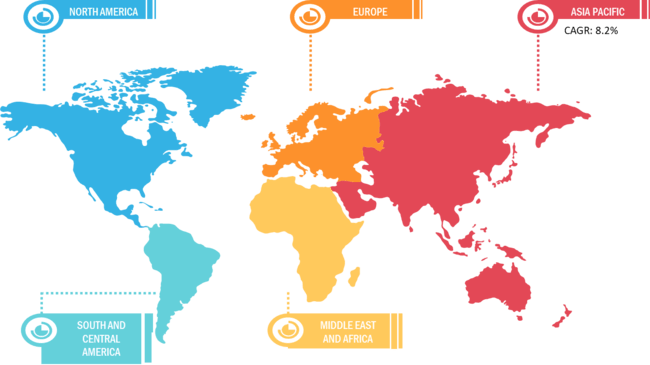Rising Consumer Concerns About Synthetic Ingredients
According to our latest market study, titled “Natural Food Colors Market Forecast to 2028 – COVID-19 Impact and Global Analysis – by Type (Carmine, Anthocyanins, Caramel, Curcumin, Annatto, Carotenoids, Chlorophyll, and Others), Form (Liquid & Gel and Powder), Application (Bakery and Confectionery, Dairy and Frozen Desserts, Beverages, Sauces; Dressings; and Condiments, RTC and RTE Products, Meat; Poultry; and Seafood, and Others), and Geography,” the global natural food colors market is projected to reach US$ 3.17 billion by 2028 from US$ 2.10 billion in 2022. It is expected to grow at a CAGR of 7.1% during 2022–2028. The report highlights key factors driving the natural food colors market and prominent players along with their developments in the market.
Over the past few years, the preference for healthy living increased dramatically. People do not want to compromise their health, which leads to increasing demand for natural food products to provide better health benefits to the human body. Natural food colors are nontoxic or less toxic in nature and have fewer side effects. People are increasingly demanding natural food colors as it is healthier and safer.
Moreover, the number of health-conscious young crowd is increasing. They are demanding organic foods mainly due to the perception that they are healthier and safer than conventional foods. Organic food is produced without synthetic fertilizers, pesticides, growth hormones, antibiotics, and genetically modified organisms (GMOs). In organic food, natural food colors are highly used to make them more appealing and appetizing. This factor is expected to create additional demand for natural food colors over the forecast period. Synthetic food colors are manufactured by chemical reactions and have various side effects, whereas natural food colors are safer to consume. Thus, the factors mentioned above are driving the natural food colors market.
There are several regulations on the use of synthetic colors in the food & beverages industry, as consuming too much synthetic food colors containing contaminants could pose a health risk. Natural food colors contain antioxidants that aid in building body immunity and act as an immunity booster. As a result, the growing awareness of the same among consumers is driving the demand for natural colors. Furthermore, the increasing demand for natural food colors from various industries such as bakery and confectionery, dairy and frozen desserts, beverages, sauces; dressings; and condiments, RTC and RTE, meat; poultry; and seafood is contributing to the market growth. Moreover, stringent rules and regulations on the use of synthetic food colors are further augmenting the natural food colors market growth.
Koninklijke DSM N.V., Sensient Technologies, Archer Daniels Midland Company, Döhler Group, BASF SE, Naturex S.A, Aromata Group, Givaudan, Dupont, Oterra A/S, and Mane KANCOR are the key players operating in the global natural food colors market. These companies provide a wide range of product portfolios for the market and have a widespread global presence, which provides a lucrative opportunity to serve a large set of customers and increase the market share. These market players are highly focused on developing products with advanced technology platforms to serve their customers better.
Impact of COVID-19 Pandemic on Natural Food Colors Market
The COVID-19 pandemic initially affected the global natural food colors market due to the shutdown of manufacturing units, rise in seafood prices, shortage of labor, disruption of supply chains, and financial instability.
The natural food colors market is a part of the food & beverages industry. The economic slowdown caused by the COVID-19 outbreak declined the industry’s growth, restraining the demand for natural food colors. However, businesses are gaining ground as previously imposed limitations have been eased across various countries. Moreover, the introduction of COVID-19 vaccines by governments of different countries eased the situation, leading to the rise in business activities worldwide. The COVID-19 pandemic also collaterally resulted in the growth of several segments of the food & beverages industry post recovery from the production disruptions. The COVID-19 pandemic led people to stay at home for a long time, under quarantine or otherwise, which increased the focus on RTE and RTC products. The increase in demand for RTE and RTC products led to a surge in the natural food colors market growth.
Global Natural Food Colors Market Breakdown – by Region

Natural Food Colors Market by Size, Share & Trend Analysis 2028
Download Free SampleNatural Food Colors Market Forecast to 2028 - COVID-19 Impact and Global Analysis By Type (Carmine, Anthocyanins, Caramel, Curcumin, Annatto, Carotenoids, Chlorophyll, and Others), Form (Liquid & Gel and Powder), and Application (Bakery and Confectionery, Dairy and Frozen Desserts, Beverages, Sauces; Dressings; and Condiments, RTC and RTE Products, Meat; Poultry; and Seafood, and Others)
The report includes the segmentation of the global natural food colors market as follows:
Based on type, the global natural food colors market is segmented into carmine, anthocyanins, caramel, curcumin, annatto, carotenoids, chlorophyll, and others. In terms of form, the market is segmented into liquid & gel and powder. Based on application, the global natural food colors market is segmented into bakery and confectionery, dairy and frozen desserts, beverages, sauces; dressings; and condiments, RTC and RTE products, meat; poultry; and seafood, and others.
By geography, the natural food colors market is broadly segmented into North America, Europe, Asia Pacific (APAC), the Middle East & Africa (MEA), and South & Central America. The market in North America is further segmented into the US, Mexico, and Canada. The Europe market is segmented into Germany, France, Italy, the UK, Russia, and the Rest of Europe. The market in Asia Pacific is segmented into Australia, China, India, Japan, South Korea, and the Rest of Asia Pacific. The market in the Middle East & Africa (MEA) is further segmented into South Africa, Saudi Arabia, the UAE, and the Rest of the MEA. The market in South & Central America is segmented into Brazil, Argentina, and the Rest of South & Central America.
Contact Us
Phone: +1-646-491-9876
Email Id: sales@theinsightpartners.com